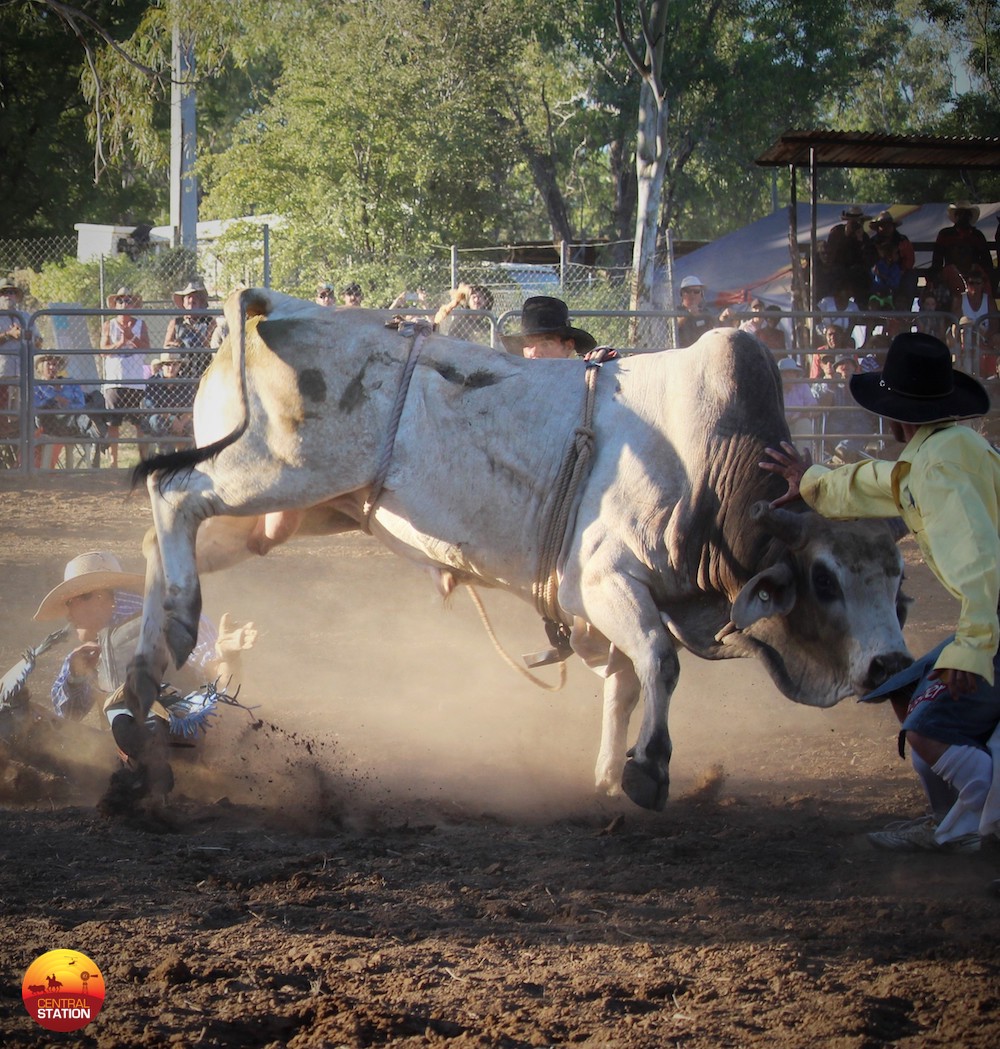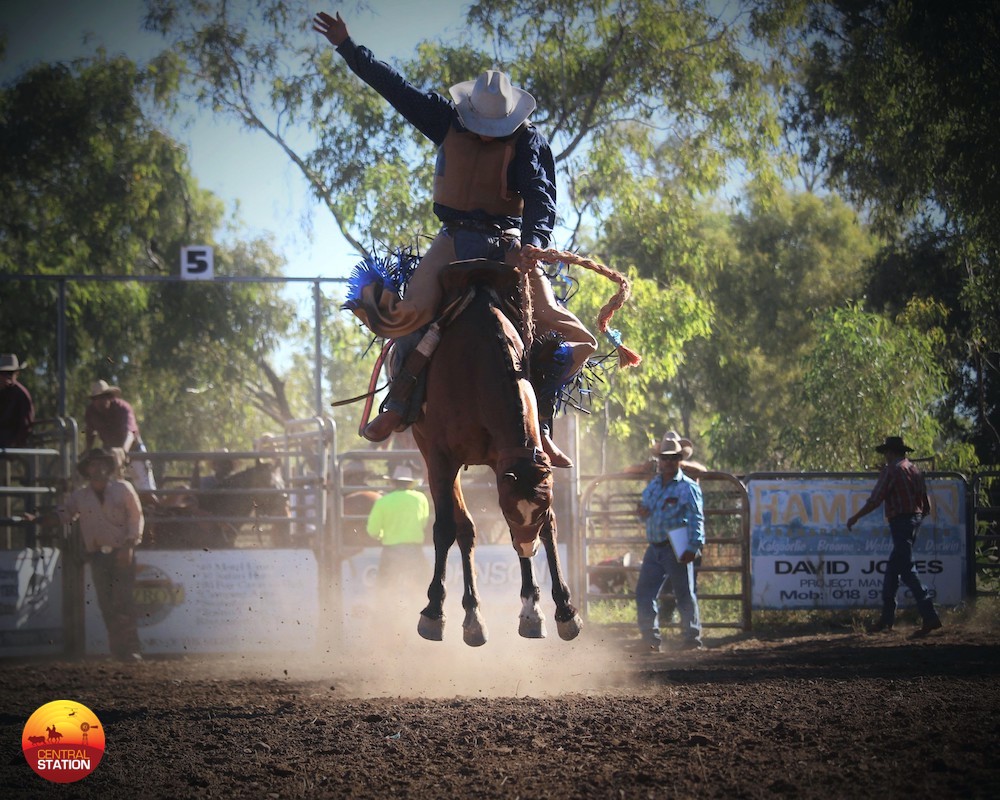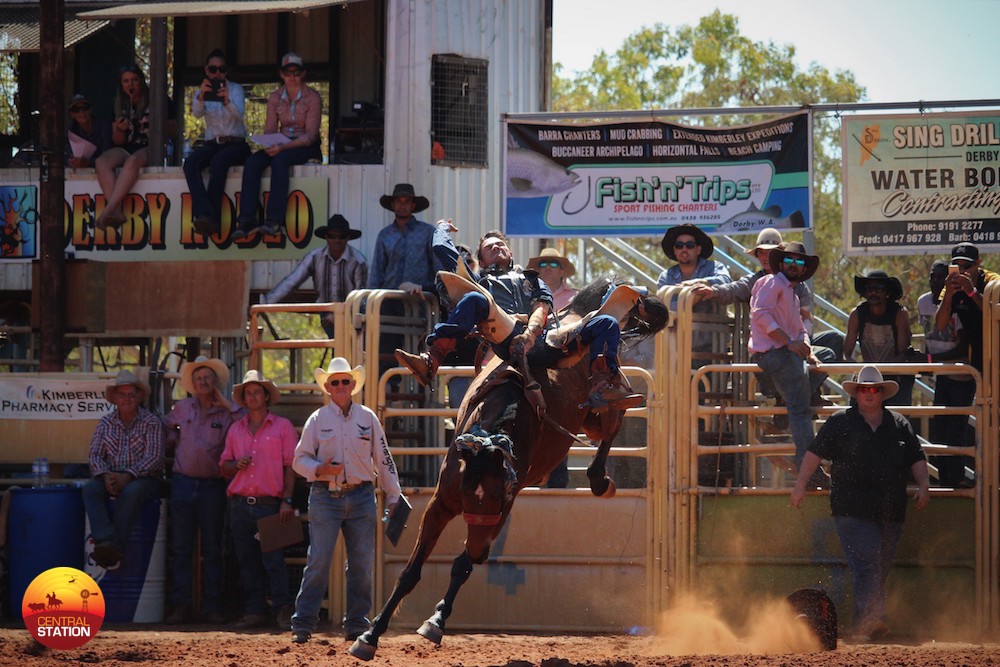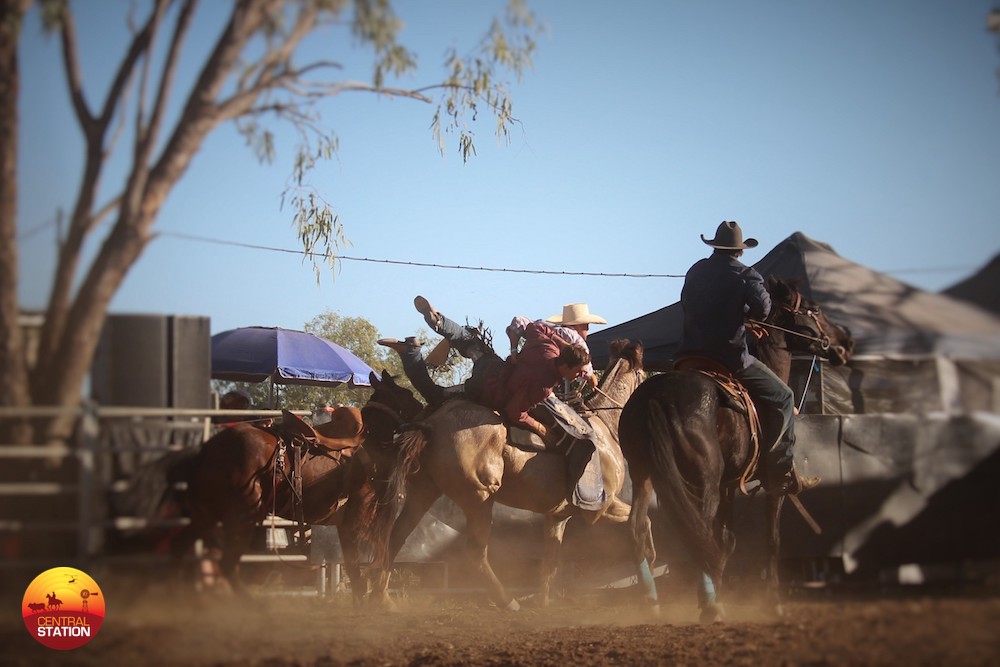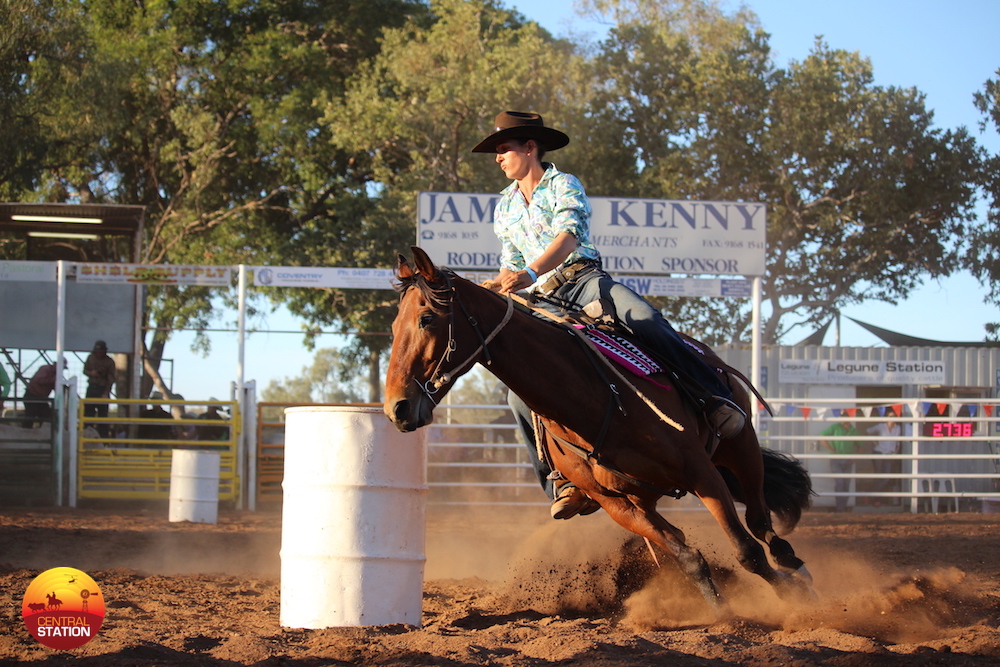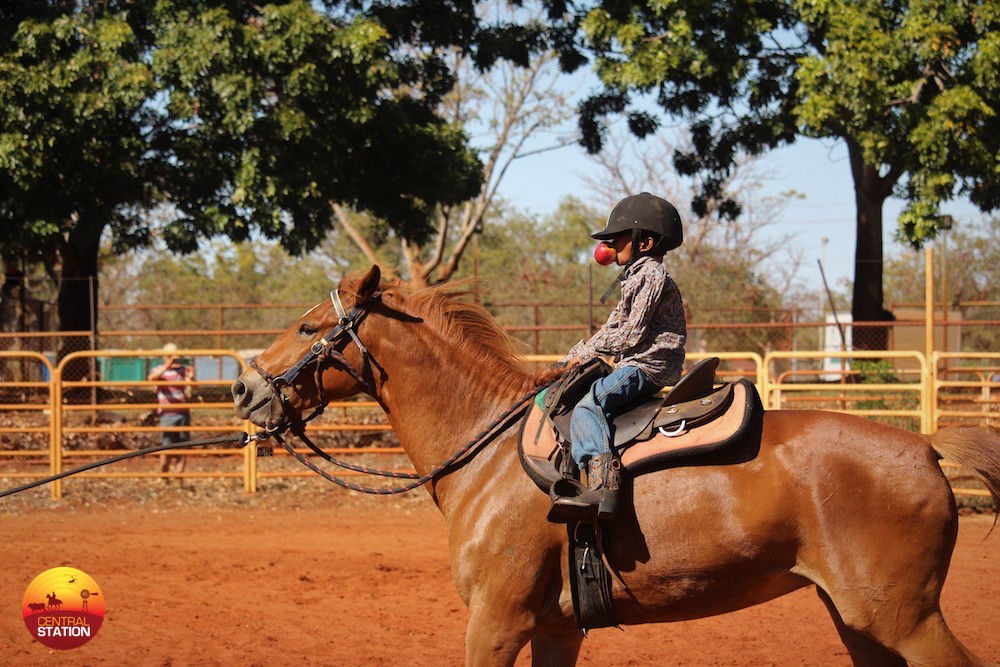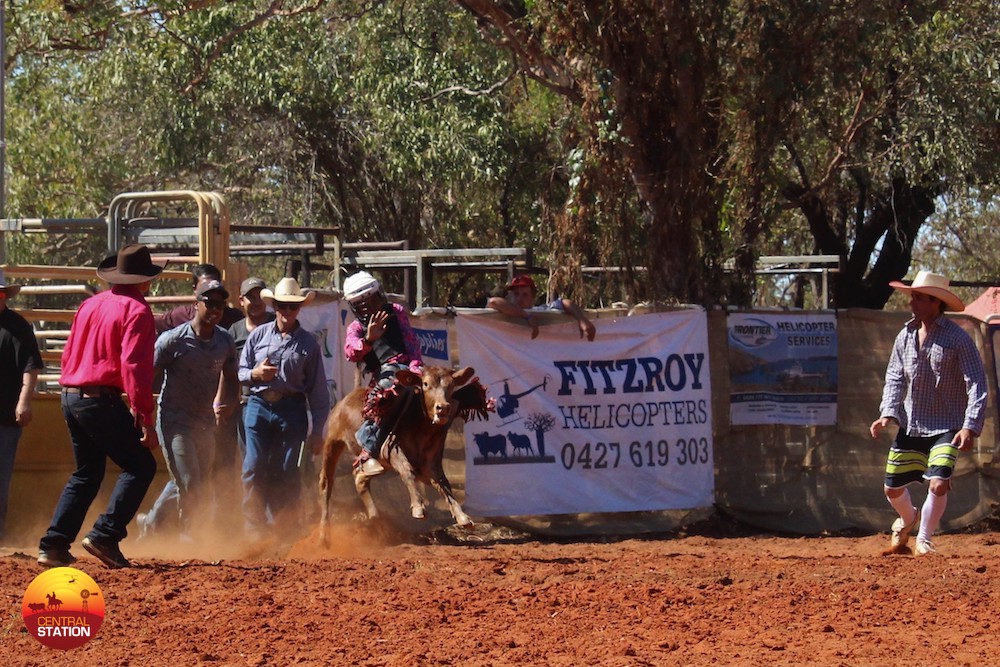Rodeo time
Written by Emma Moss
Rodeos are a major part of the social life for those living on a station. Up in the Kimberley, rodeos and camp drafts are often held over the same weekend – as people travel so far to these events, it makes sense to save a trip and hold two events at once.
During the day for the first couple of days, the campdraft competition takes place. Campdrafting can be split into 2 sections. The first bit is in “the camp” where riders must “cut out” (separate) one beast from the mob of cattle in the yard. With the rest of the mob behind the rider, the beast must be blocked and turned at least 2 or 3 times to prove that the rider has the beast under control. This is similar to old methods of drafting cattle back before helicopters and portable yards.
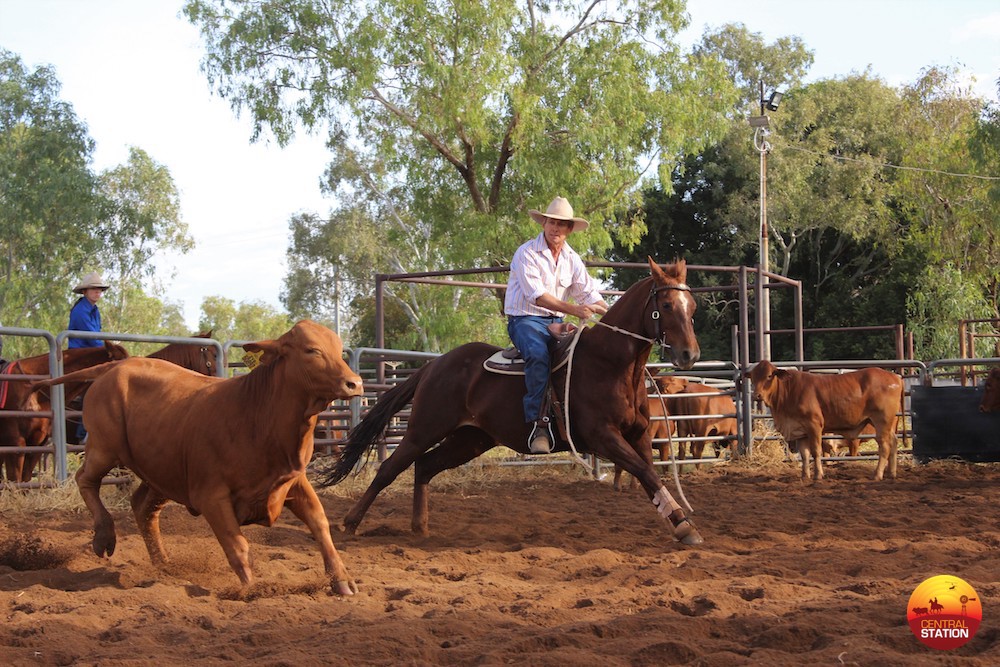
Cutting Out
The rider then calls for the gate to be opened where they take the beast out of the yard and through a course around pegs involving right and left hand turns in a figure eight, before guiding it through two pegs known as “the gate”. The outside course must be completed in less than 40 seconds to gain a score. This is similar to skills required as a stockman if cattle run break the mob during a muster.
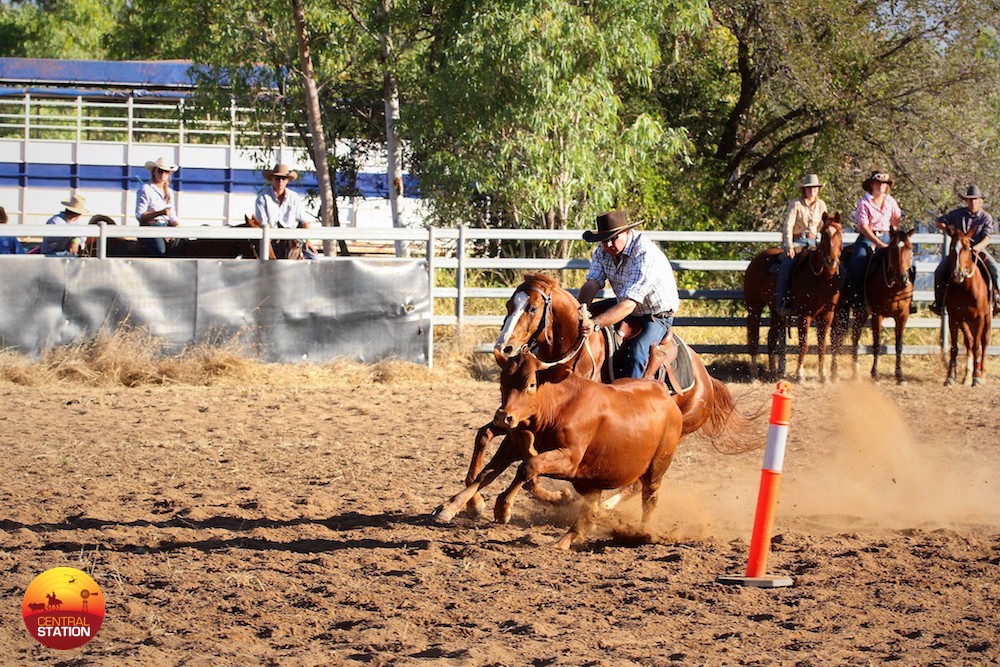
Out of the camp.
There are various events in the campdraft, some depending on skill level of rider, horse or both.
Towards the evening, the rodeo events take place. If not competing, this is where people settle around the bar or the arena to watch.
Steer Wresting (via prorodeo.com)
Steer wrestling demands coordination between two mounted cowboys – the contestant and a hazer who controls the steer’s direction – and their horses. The cowboys back their horses into the box on each side of the steer. When the contestant nods, the chute gate opens and the steer gets a head start before the cowboys start to chase him. As the steer wrestler draws even, he dismounts from his horse, which is moving at perhaps 30 miles an hour. He grasps the steer’s horns and digs his boot heels into the dirt to slow down the 500- to 600-pound steer. Then he wrestles the steer onto its side; when all four legs point in the same direction, the clock stops. Times vary widely depending on the size of the arena.
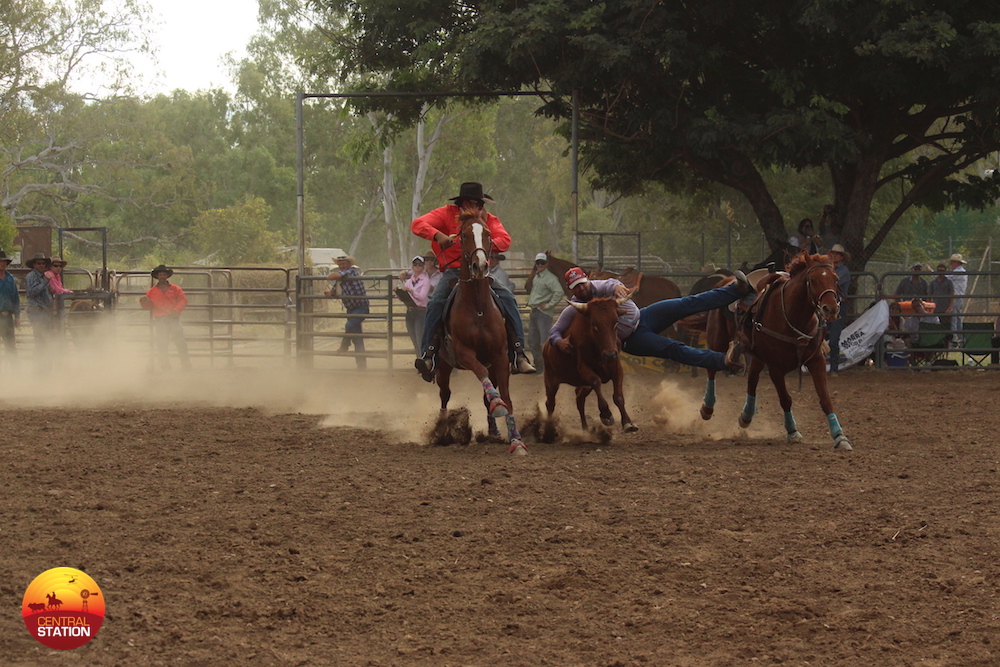
Steer wrestling.
Steer undecorating originated to be the female version of steer wrestling. Rather than dismounting the horse and pulling the steer to the ground, the competitor must canter on their horse along side the steer, reach down and remove the ribbon attached to the steers back.
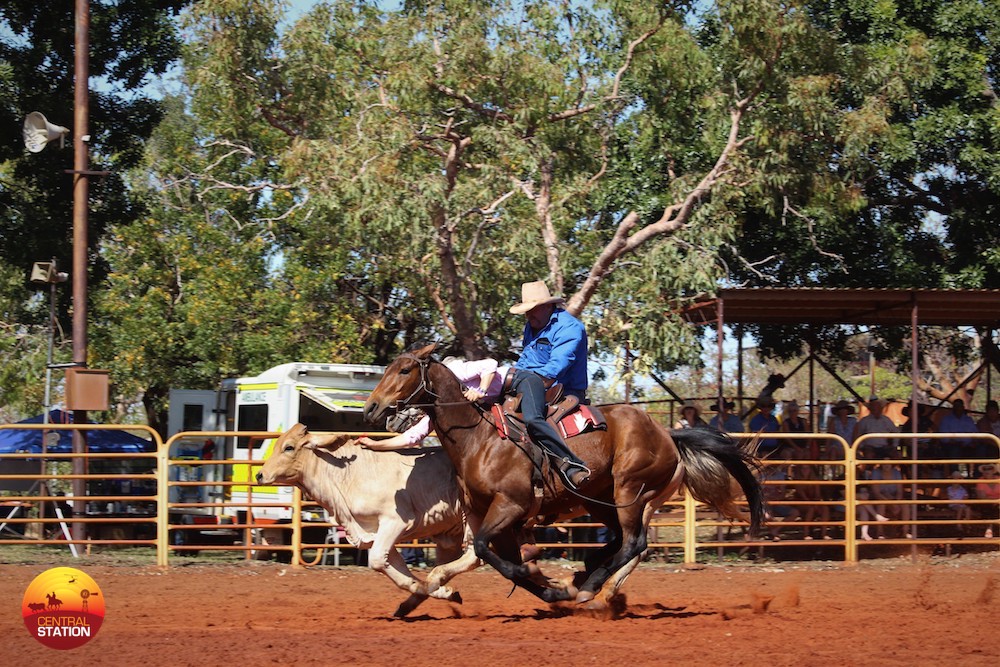
Steer Undecorating.
Team Roping (via prorodeo.com)
Team ropers work as partners: one header and one heeler who move in precise coordination. They and their horses start in the “box.” When the header nods, the chute gate opens and the steer gets a head start. The header throws the first loop, which must catch the steer’s head or horns, protected by a horn wrap. Then the header dallies – wraps his rope around his saddle horn – and moves his horse to pull the rope taut, changing the direction of the steer. That gives the heeler the opportunity to catch both of the steer’s hind legs with his own rope; most heelers try to time their throws to catch the legs when they are in the air. After the catch, the heeler also dallies, to stop the steer. When the ropes are taut and both horses face the steer, the time is recorded. Times vary widely depending on the size of the arena.
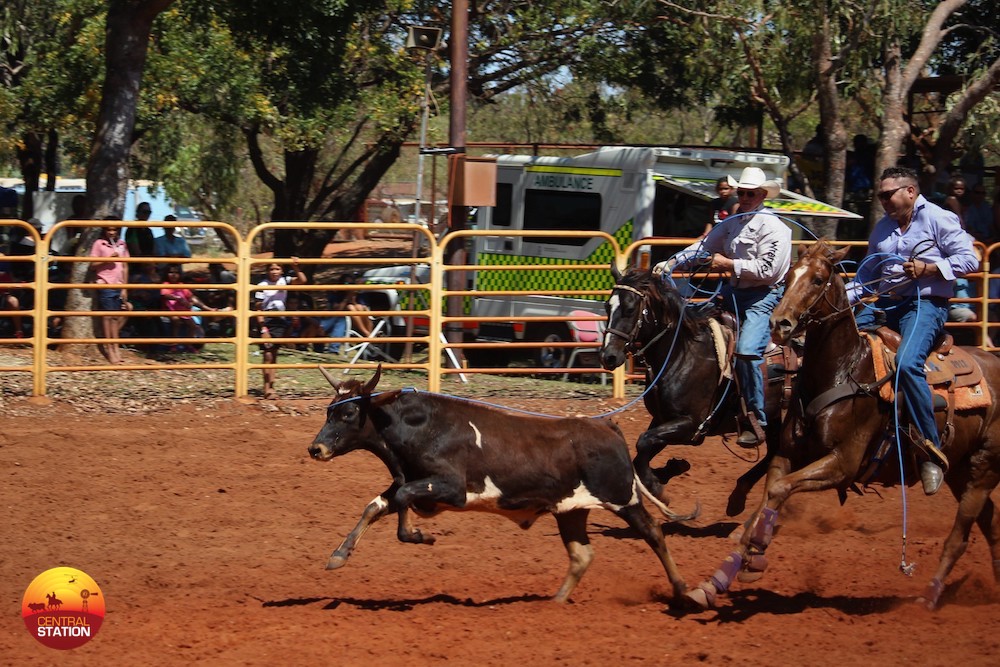
Team Roping.
The ladies heifer ride has the same rules as a bull ride. However instead of bulls she rides a smaller heifer (young cow).
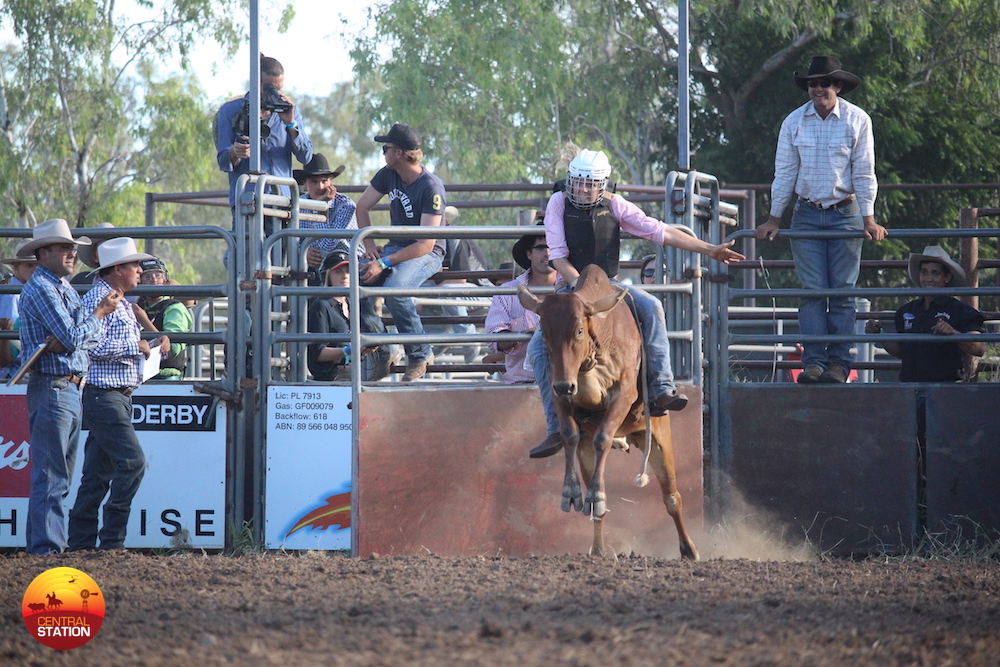
Ladies heifer ride.
The station buckjump is an Australian originated rodeo sport. The rider starts in the shoots on a saddled ‘bronc’ horse with a whip in their hand. They must ride the bucking horse for 8 seconds and crack the whip 3 times. This originated from bucking out wild horses whilst breaking them in (training them). Now days, however, these horses are bred specifically for their strength, agility and bucking ability.
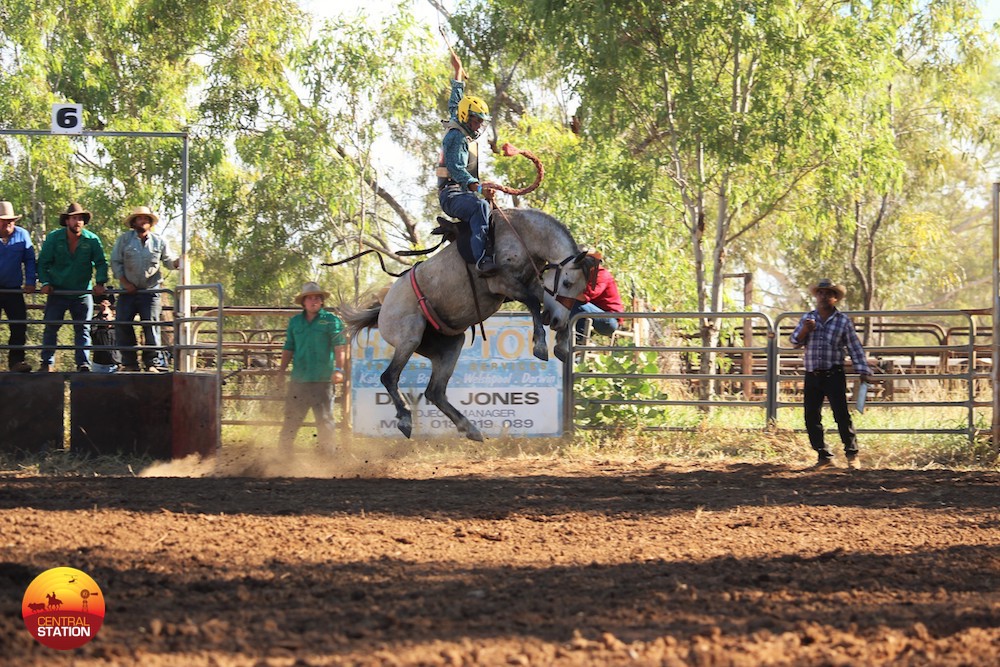
Station buckjump.
The ladies station buckjump is the station buckjump for the few ladies brave enough to have a go.
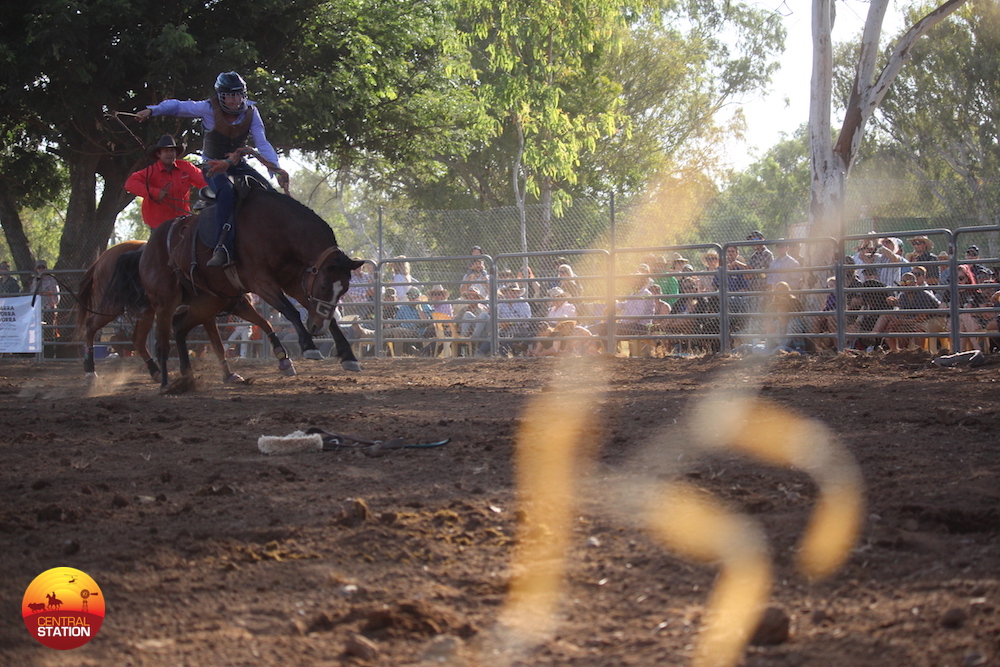
Ladies buck jump.
The bull ride is probably what comes to mind when most people think rodeo. The rider is scored on how well they ride as well as how hard to the bull is to stay on. One hand is tied down with a rope and the other hand is not allowed to touch the bull at anytime. If the rider stays on for 8 seconds then a score will be given.
Bull riding (via prorodeo.com)
Bull riding is rodeo’s most dangerous event. In the chute, the bull rider settles on the bull’s back, wraps his braided rope around the bull’s girth, then loops the rope around his hand and back into his palm so he can grip it tightly. When he nods, the gate is opened and the bull lunges out of the chute. Spurring is optional – the primary goal for the cowboy is to stay on for eight seconds without touching himself, his equipment or the bull with his free hand. The cowboy will be scored highly for staying in the middle of the bull, in full control of the ride. If the ride lasts the required eight seconds, it is scored by two judges who assess difficulty (the bull’s spinning, jumping and kicking, lunging, rearing and dropping, and sideto- side motion) as well as the cowboy’s degree of control. Each judge awards up to 25 points for the cowboy’s performance and up to 25 points for the animal’s performance, for a potential of 100 points.
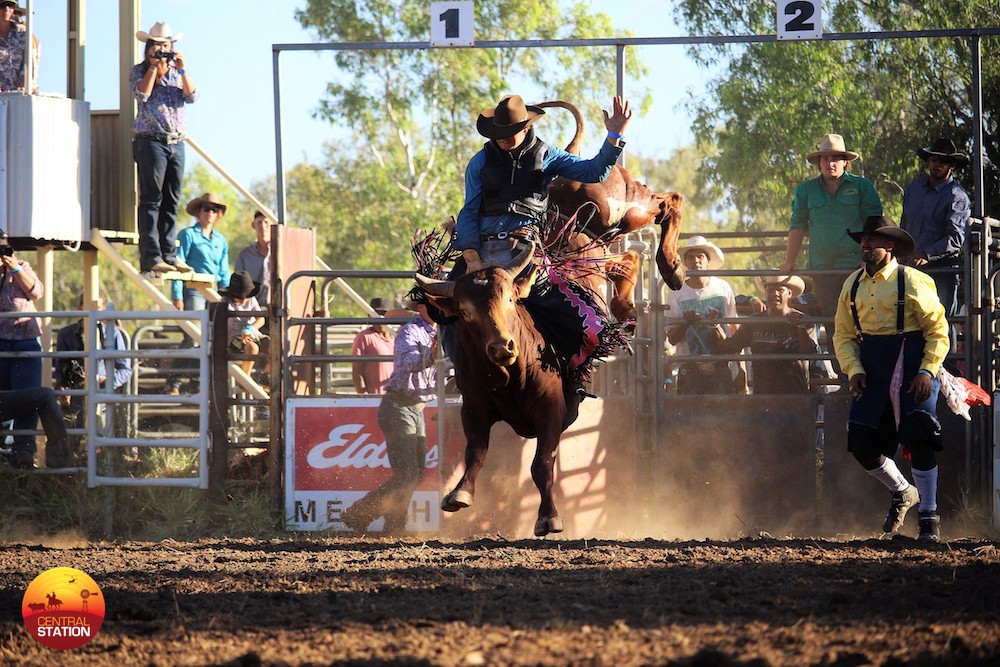
Bull riding
The bull fighters at the rodeo are, in my opinion, some of the most important people there. Their job is to keep all the riders as safe as they can. They run around the bulls working as a team to aid the rider if necessary and distract the bull at the end of the ride so the bull rider.
Bull fighters (via prorodeo.com)
Athletes who protects the bull rider after he dismounts or is bucked off by distracting the bull and directing its attention to the exit gate, sometimes stepping between the bull and the bull rider.
Bullfighters
Saddle Bronc (via prorodeo.com)
In rodeo’s classic event, the saddle bronc rider sits on a specialized saddle – it has no horn, and the stirrups are set forward. In the chute, the cowboy adjusts his grip on the rein and perhaps the horse’s position. When the gate opens, his boots must be above the breaks of the horse’s shoulders. After the horse’s first move, usually a jump, the cowboy begins spurring in long, smooth strokes, in sync with the horse’s jumps – legs straight when the bronc comes down, toward the back of the saddle at the top of the jump. His only handhold is a six-foot braided rope; his free hand may not touch his equipment, his body or the horse. If the ride lasts the required eight seconds, it is scored by two judges – one on each side – who assess difficulty and control. Each judge awards up to 25 points for the cowboy’s performance and up to 25 points for the animal’s performance, for a potential of 100 points.
Saddle bronc.
Bareback riding (via ProRodeo.com)
Bareback riding is one of the most physically demanding events in rodeo. A bareback rider sits directly on a bucking horse, with only his own “riggin’” to hang onto. As the horse comes out of the chute, the cowboy’s feet must be above the break of the horse’s shoulders. He holds his feet up at least through the horse’s first move, usually a jump, then spurs the horse on each jump, matching the horse’s rhythm and showing control rather than flopping around. He may not touch the horse, his equipment or himself with his free hand. If the ride lasts eight seconds, two judges award up to 25 points each for the cowboy’s “exposure” to the strength of the horse and his spurring technique and up to 25 points each for the horse’s bucking strength and moves.
In the Kimberley there is one main horse breeder that supplies the horse “string” for the rodeo circuits. These horses are halter trained and more often than not, quiet behind the chute. They only get ridden about 8 times a year before being spelled in the paddock.
Bareback.
The pickup men are two mounted cowboys who help riders dismount, release a bucking horse’s soft flank strap, and escort bucking horses and bulls to the exit gate after a ride.
The pickup team in action.
Barrel Racing (via prorodeo.com)
Barrel racing is just that – a race against time in a cloverleaf pattern around three barrels set up in the arena. A rider can choose to begin the cloverleaf pattern to the right or left. The time begins when the horse and rider cross the predetermined start line and stops when they come back across the same line. Each run is timed to the hundredths of a second, making every fraction of a second count. (Starting in 2012, Canadian rodeos now time to the thousandth of a second.) Each tipped-over barrel adds a five-second penalty to the time.
Barrel Racing.
The kids also love to have a go at most sporting events. Some even do the poddy ride.
Campdrafts and rodeos are the highlight of the social calendar in the north – if you ever get the chance, don’t think twice!

